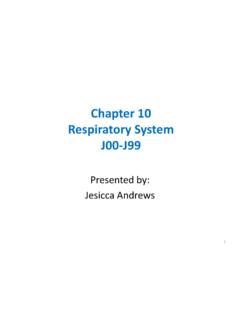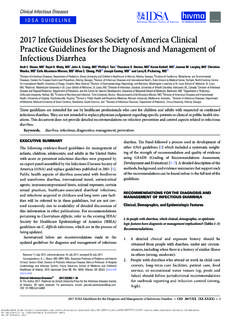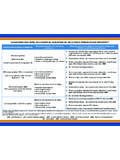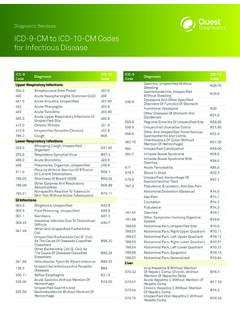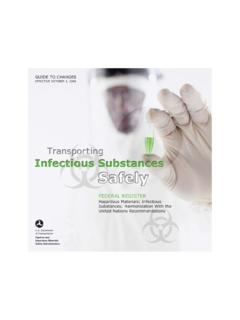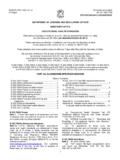Transcription of INFECTIOUS AND PARASITIC DISEASES A00 B99 - …
1 INFECTIOUS AND PARASITIC DISEASESA00 B99 Presented byJan HalloranINTRODUCTIONC hapter 1 of ICD-10 classifies INFECTIOUS and PARASITIC DISEASES that are easily transmissible (communicable). The primary axis for this chapter is the organism responsible for the condition. INFECTIOUS and PARASITIC conditions are classified in one of several ways, making careful use of the Alphabetic Index OF ADDITIONAL CODES FROM CHAPTER 1 TO IDENTIFY THE ORGANISM Certain infections are classified in chapters other than Chapter 1 and no organism is identified as part of the infection code. In these instances, it is necessary to use an additional code from Chapter 1 to identify the organism:Example: Urinary tract infection due to Urinary tract infection, site not Enterococcusas the cause of DISEASES classified elsewhereCOMBINATION CODES Combination codes frequently identify both the condition and the Mumps zoster conjunctivitisDUAL CLASSIFICATION Dual classification is used extensively for Chapter 1:Example:B49+ J99 BronchomycosisThis code appears in the Index as follows.
2 Bronchomycosis NOS B49 [J99]*When a code appears with a code in brackets after it, you always code both codes in this VS SITE/OTHER SUBTERM A thorough search of the Alphabetic Index is required in coding infection. When the main term for the condition has been located, a subterm for the organism always takes precedence over a more general subterm (such as acute or chronic ) when both subterms occur at the same indention level in the Alphabetic Index. For example, the diagnosis of chronic cystitis due to gonococcus, the Alphabetic Index provides subterms for both chronic and gonococcal:Cystitis (exudative) .. chronic .. gonococcal In this case, only code is assigned because the subterm for the organism takes precedence over the subterm "chronic.
3 "WEST NILE VIRUS FEVER Subcategory is used to report West Nile virus infection. The virus is transmitted to humans by the bite of a mosquito that has bitten an infected bird. Most healthy people infected by the virus have few symptoms or have a mild illness consisting of fever, headache, and body aches prior to recovering. In elderly patients or those with a weakened immune system, the virus may cause encephalitis, meningitis, or permanent neurological damage and may be life threatening. Subcategory is further subdivided to distinguish between:West Nile virus infection Nile virus infection Nile virus infection Nile virus infection with other neurologic West Nile virus infection with other complications This expansion allows the differentiation between the milder cases of the disease and those with more serious complications and neurological we do not see Tuberculosis often, is the diagnosis code for a positive tuberculin skin test without a diagnosis of tuberculosis.
4 Included in this code are the following: Nonspecific reaction to tuberculin skin test without active tuberculosis Positive tuberculin skin test without active tuberculosis Positive PPD (skin test) Abnormal result of Mantoux test Tuberculin (skin test) positive Tuberculin (skin test) reactor CODING EXERCISE #1 Code the following diagnoses:1) Postmeasles otitis media2)Acute scarlet fever 3) Herpes zoster of conjunctiva ANSWERS EXERCISE #11) Postmeasles otitis media: )Acute scarlet fever: ) Herpes zoster of conjunctiva: , SEVERE SEPSIS, AND SEPTIC SHOCKTERMS TO KNOW Bacteremiapresence of bacteria in the bloodstream after a trauma or an infection SepsisSIRS due to infection; a severe case indicates organ dysfunction Septic shockcirculatory failure associated with severe sepsis Septicemiaa systemic disease associated with pathological microorganisms or toxins in the bloodstream SIRS systemic inflammatory response syndrome; a systemic response to infection or trauma with such symptoms as fever and tachycardia BACTEREMIA Bacteremia( ) refers to the presence of bacteria in the bloodstream after trauma or mild infection.
5 This condition is usually transient and ordinarily clears promptly through the action of the body's own immune a diagnosis of sepsis, the appropriate code for the underlying systemic infection should be assigned. One example is Streptococcal sepsis, it is classified to category A40with the third character specifying sepsis due to different streptococci strains as due to streptococcus, group Sepsis due to streptococcus, group B due to streptococcal Streptococcal sepsis, unspecifiedSIRS/SYSTEMIC INFLAMMATORY RESPONSE SYNDROME Systemic inflammatory response syndrome (SIRS) generally refers to the systemic response to infection, trauma/burns, or other insult (such as cancer), with symptoms including fever, tachycardia, tachypnea, and leukocytosis.
6 SIRS of noninfectious origin is coded to subcategory on whether there of noninfectious origin without organ of noninfectious origin with organ dysfunctionSEVERE SEPSIS AND SEPTIC SHOCK Severe sepsis (subcategory ) generally refers to sepsis with associated acute or multiple organ dysfunction. Subcategory further subdivided to identify the following: sepsis without septic sepsis with septic shock Septic shock generally refers to circulatory failure associated with severe sepsis and therefore represents a type of acute organ dysfunction. The physician must specifically record "septic shock" in the diagnostic statement in order to code it as such. Septic shock indicates the presence of severe sepsis and code , Severe sepsis with septic shock,must be assigned, even if the term "severe sepsis" is not Sepsis The coding of severe sepsis requires a minimum of two codes: Sequence first a code for the underlying infection followed by a code from , Severe sepsis.
7 If the causal organism is not documented, assign code , Sepsis, unspecified organism,for the infection. An additional code(s) should also be assigned for the associated acute organ dysfunction. Sepsis and Severe Sepsis with a Localized Infection When the reason for the admission is both sepsis, or severe sepsis, and a localized infection (such as, pneumonia or cellulitis): The code for sepsisshould be assigned as the first/principal diagnosis. The code for the pneumonia or cellulitis should be assigned as a secondary diagnosis. If the patient has severe sepsis, a code from subcategory also be assigned as a secondary diagnosis. If the patient is admitted with pneumonia or cellulitis, and the sepsis/severe sepsis does not develop until after admission, the sepsis/severe sepsis would be secondary due to a Postprocedural Infection As with all postprocedural complications, code assignment for sepsis due to a postprocedural infection is based on the provider's documentation of the relationship between the infection and the procedure.
8 The following codes should be coded following infusion, transfusion, and therapeutic following a procedure following of obstetric surgical wound Followed by the code for the specific infection. In addition, for severe sepsis, the appropriate code from subcategory should also be assigned along with the code(s) for any acute organ due to a Postprocedural Infection Postprocedural infections can result in severe sepsis and postprocedural septic shock. In these cases, the code for the precipitating complication should be coded following a procedure,or Infection of obstetrical surgical wound Followed by sepsis with septic shock Code for the systemic infectionSepsis and Severe Sepsis Associated with a Noninfectious Process In some cases, a noninfectious process such as trauma, may lead to an infection that can result in sepsis or severe sepsis.
9 If sepsis or severe sepsis is documented as associated with a noninfectious condition, such as a burn or serious injury, and this condition meets the definition for principal diagnosis: the code for the noninfectious condition should be sequenced first, followed by the code for the resulting EXERCISE #2 Code the following diagnoses:1)Anaerobic gram-negative sepsis2)Sepsis due to methicillin-resistant Staphylococcus aureus(MRSA)3)Streptococcal sepsisANSWERS EXERCISE #21)Anaerobic gram-negative sepsis: )Sepsis due to methicillin-resistant Staphylococcus aureus(MRSA): )Streptococcal sepsis: AND OTHER HIV INFECTIONSB ecause the human immunodeficiency virus (HIV) infection has become a major health care concern, the collection of accurate and complete data on conditions associated with HIV infection is important for health care resource planning.
10 Code B20is assigned for all types of HIV infections, which are described by a variety of terms, such as the following: AIDS Acquired immune deficiency syndrome Acquired immunodeficiency syndrome AIDS-related complex (ARC) AIDS-related conditions HIV infection, symptomatic Serologic Testing for HIV Infection When an asymptomatic patient with no prior diagnosis of HIV infection or positive-HIV status requests testing to determine his or her HIV status, use for screening for human immunodeficiency virus [HIV]. When the patient makes a return visit to learn the result of the serology test, code: immunodeficiency virus [HIV] counseling,should be assigned as the reason for the encounter when the test result is negative, inconclusive (R75), or of HIV-Related Diagnoses When a patient is admitted for treatment of an HIV infection or any related complications, code B20, Human immunodeficiency virus (HIV) disease ,is sequenced as the principal diagnosis, with additional codes for the HIV-related conditions.

